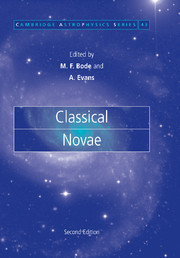Book contents
- Frontmatter
- Contents
- List of contributors
- Preface to the first edition
- Preface to the second edition
- List of symbols
- 1 Novae: an historical perspective
- 2 Properties of novae: an overview
- 3 The evolution of nova-producing binary stars
- 4 Thermonuclear processes
- 5 Nova atmospheres and winds
- 6 Observational mysteries and theoretical challenges for abundance studies
- 7 Radio emission from novae
- 8 Infrared studies of classical novae
- 9 Optical and ultraviolet evolution
- 10 X-ray emission from classical novae in outburst
- 11 Gamma-rays from classical novae
- 12 Resolved nebular remnants
- 13 Dust and molecules in nova environments
- 14 Extragalactic novae
- Object index
- Subject index
9 - Optical and ultraviolet evolution
Published online by Cambridge University Press: 10 October 2009
- Frontmatter
- Contents
- List of contributors
- Preface to the first edition
- Preface to the second edition
- List of symbols
- 1 Novae: an historical perspective
- 2 Properties of novae: an overview
- 3 The evolution of nova-producing binary stars
- 4 Thermonuclear processes
- 5 Nova atmospheres and winds
- 6 Observational mysteries and theoretical challenges for abundance studies
- 7 Radio emission from novae
- 8 Infrared studies of classical novae
- 9 Optical and ultraviolet evolution
- 10 X-ray emission from classical novae in outburst
- 11 Gamma-rays from classical novae
- 12 Resolved nebular remnants
- 13 Dust and molecules in nova environments
- 14 Extragalactic novae
- Object index
- Subject index
Summary
Introduction
Astrophysical spectroscopy, and with it our understanding of the cause and progression of the nova event, has progressed apace in the past two decades. When the ink was drying on the first edition, the International Ultraviolet Explorer (IUE) satellite was still in its heyday and many new phenomena related to the outburst were still to be discovered. Some glimpses had been provided by the Copernicus satellite (for V1500 Cyg), but the Hubble Space Telescope, and with it the Goddard High Resolution Spectrograph (GHRS) and the Space Telescope Imaging Spectrograph (STIS), were waiting to be launched and CCD technology was just being developed. Historically, much of the early work on ultraviolet spectra was undertaken with the aim of determining abundances through analyses of the nebular spectra. This is understandable since, before the early 1980s, the optically thick stage was impossible to model. Theoretical models have guided a shift in methodology, as did the development of spectrophotometric capabilities. One point should, however, be emphasized: no nova – classical or recurrent – was observed panchromatically before the Copernicus and IUE satellites were launched in the 1970s and the classical analyses were based entirely on data longward of the atmospheric cut-off. As we will discuss, we now know the role played by the ultraviolet in the details of spectrum formation at all wavelengths, a view that has changed dramatically since the first edition of Classical Novae, so it is this connection that will be stressed throughout this chapter.
- Type
- Chapter
- Information
- Classical Novae , pp. 194 - 231Publisher: Cambridge University PressPrint publication year: 2008
- 16
- Cited by



